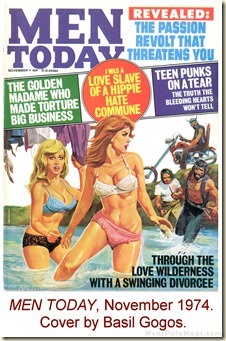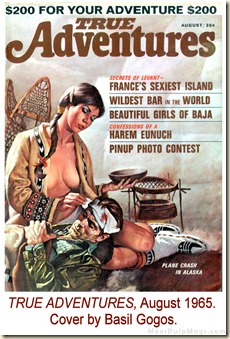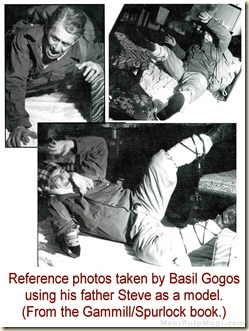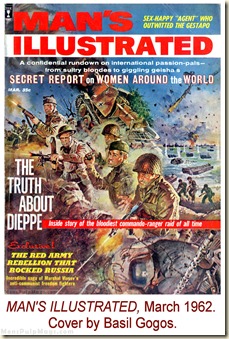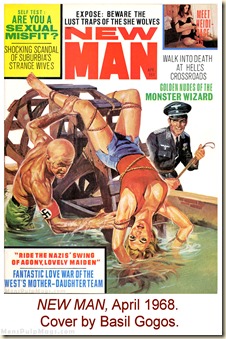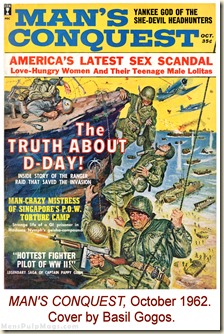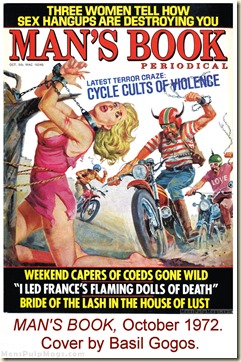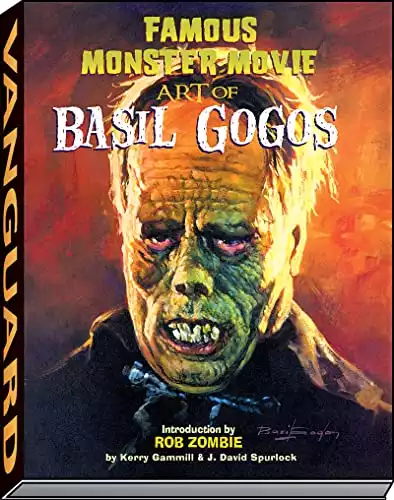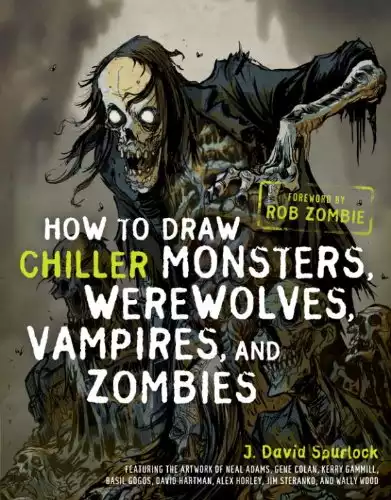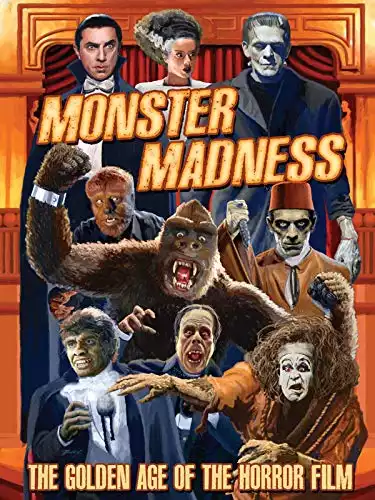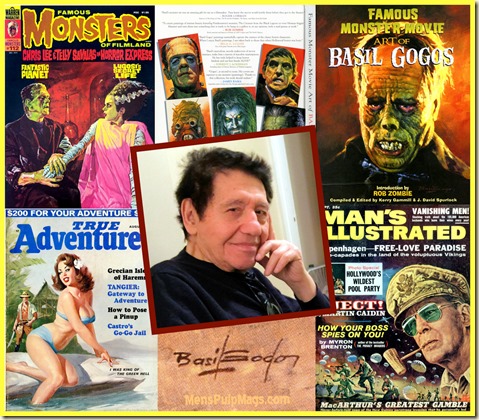
Artist Basil Gogos is the most widely-known and revered painter of movie monster paintings in the world.
His reputation as the King of Monster Art was first established in the 1960s and 1970s.
During those first two decades of his career as a professional illustration artist, Basil created dozens of wildly colorful and wicked cool cover paintings for the James Warren periodical FAMOUS MONSTERS OF FILMLAND and the Warren Publishing horror magazines EERIE and CREEPY.
In more recent decades, the popularity of Basil’s monster artwork has continued to grow.
He has created many new monster portrait paintings that are even more masterful than his FAMOUS MONSTERS covers.
He has done horror-themed album cover paintings for his fans in the heavy metal music world, Rob Zombie, The Misfits and Electric Frankenstein.
He also maintains a busy schedule of appearances at comic and horror conventions held throughout the country.
At the cons, and through his Facebook page, Basil sells and autographs prints and t-shirts featuring his monster paintings.
Many are portraits of classic horror and science fiction movie characters, such as Dracula, the Wolf Man, Frankenstein’s monster, Godzilla, King Kong and The Creature from the Black Lagoon.
Others are portraits of famous actors who starred in those movies, like Lon Chaney, Peter Cushing, Boris Karloff, Christopher Lee and Bela Lugosi.
At the cons, Basil also brings along copies of the gorgeous, full-color book about his artwork published by Vanguard Productions, titled the FAMOUS MONSTER ART OF BASIL GOGOS.
That book is a must-have for fans of Basil, the Warren magazines, classic monster flicks and illustration art.
It was compiled and edited by artist Kerry Gammill and Vanguard’s founder, the incredibly prolific artist, author and publisher J. David Spurlock.
Naturally, the Gammill/Spurlock book focuses on Basil’s classic FAMOUS MONSTERS covers and his more recent movie monster portrait art.
But it also devotes a chapter to a lesser-known, but significant part of the career of Basil Gogos: the work he did for men’s pulp adventure magazines between 1959 until the mid-1970s.
I believe that facet of his career deserves much wider recognition and is worthy of a book or three in itself.
In fact, Basil actually did more artwork for men’s adventure magazines than he did for the Warren monster mags.
In addition, his MAM artwork includes a more diverse range of styles and a wider variety subjects, ranging from exotic adventure and battle scenes to “sweat magazine” style bondage and torture covers and “Good Girl Art” featuring alluring femme fatales.
Basil’s work for the men’s pulp adventure magazines started in 1959, with his “Arab Peril” cover painting for the premiere issue of WILDCAT ADVENTURES (an issue I featured in several recent posts here).
It blossomed in the 1960s, when he was a frequent contributor of cover and interior art to many of the top men’s adventure mags. He continued working for the genre into its waning years in the mid-1970s, when only a handful of titles still featured painted covers and high quality interior illustrations.
Recently, with a kind assist from Basil’s partner Linda Touby, who helps maintain the Basil Gogos Facebook page (and is an artist herself), I got the opportunity to ask Basil some questions about his work for the men’s adventure magazines.
His answers are below, along with examples of his MAM cover and interior artwork…
BOB DEIS: Thanks for talking with me, Basil. I’d like to start by asking about your early training as an artist and how you came to work for men’s adventure magazines. I know your family moved to the U.S. from Egypt when you were 16 and you began studying art seriously about ten years after that. Did you know you wanted to be an artist from childhood?
BASIL GOGOS: No, I was not an artist then, though I was interested in fine arts. My mind was not set on being an artist until later. By the age of twenty-seven I suddenly realized I had to be an artist and both of my parents were supportive of my art career from the beginning. My mother was a fashion designer. She studied in Paris and later had her own fashion business in New York City with my father. I had discovered I could draw well and illustration attracted me. Then I went to Frank J. Reilly’s class at the Art Students League in New York, which was the very beginning of my career.
BOB: It’s amazing how many famous illustration artists studied under Reilly. What was it about him that made him so good as a teacher?
BASIL: Reilly insisted that there were rules to follow if you want to become an illustrator. Light and shade, the color wheel and how color works.
BOB: As you probably know, many other great artists who studied under Reilly did illustration work for men’s adventure magazines, like James Bama, Mel Crair, Ed Emshwiller, Robert Maguire, Frank McCarthy, Rudy Nappi, Sam Savitt, and Robert E. “Bob” Schulz.
BASIL: Yes, I knew some of them and remained friendly with them, like Jimmy Bama. I also knew other artists who worked for men’s adventure magazines. I knew Mort Kunstler, Tom Lovell and many others. I met them in different publishers’ offices. We would see each other and discuss our work and talk about the field of illustration.
BOB: Frank Reilly had an arrangement with the Permabooks arm of the Pocket Books company to hold cover painting contests for his students. In 1959, you won the contest for the painting to be used on the Western paperback PURSUIT by Lewis B. Patten, making it your first professional illustration sale. It looks that was also the first cover painting that features your father Steve Gogos as a model. Is that right?
BASIL: Yes, my father Steve was the model for that cover. I used him often as a model from the beginning and he turned out to be a good one.
BOB: In the Gammill/Spurlock book about you, you’re quoted as saying you got an agent around the time you were finishing your studies at the Art Students League. By any chance was that agent Ed Balcourt?
BASIL: Yes, Ed Balcourt was my agent and he gave me a lot of work. He had many contacts and so he was able to find me a lot of illustration work. He got me my first illustration jobs for men’s adventure magazines, as well as western magazine art, and some boy and girl stuff. That helped give me the experience I needed. After a while, I was established as an illustrator and stopped using him as a rep.
BOB: Interesting! Balcourt represented an amazing number of other illustration artists early their careers, including Charles Copeland, John Duillo, Bob Larkin, John Leone, Lou Marchetti, Robert Maguire, James Meese, Bruce Minney, Paul Rader, Tom Ryan and Bob Schulz. Another thing I noticed in the Gammill/Spurlock book are some of the photos you took as references for your artwork. Was taking reference photos one of the things you learned from Frank Reilly?
BASIL: Yes, Reilly did teach that and I took the photos I used for reference myself. I had props and costumes and brought models to my studio. I set up my own cameras to take the pictures.
BOB: For a lot of your men’s adventure magazine illustrations you used Steve Holland, who was the favorite male model of many of the New York-based illustration artists back then. He was especially popular with artists who did a lot of work for men’s adventure magazines, like James Bama, Norman Baer, Mel Crair, Norm Eastman, Mort Kunstler, Bruce Minney, Al Rossi and many others.
BASIL: Yes, Steve Holland was the backbone for most of the pictures I took for my men’s adventure magazine illustrations. His looks were terrific. Tall and handsome. Everyone liked him. He was very personable and easy to work with. We all used Steve because he was stunning and very professional. The perfect model. And he was not expensive. I would usually book him for sessions that would last about an hour, sometimes two hours. I used my father as often as I could. He was terrific. I used my brother and myself as well. I used myself very often as a model. I used a lot of different female models, both professional models and women I knew.
BOB: In the book about you, you mention that one of your favorite female models was Joan Stein. Is that her in the illustration on page 57 in the book, with Steve Holland turning into a werewolf in the foreground?
BASIL: Yes, Joan Stein was the model with Steve Holland in that one.
BOB: Another artist who used Steve Holland for many of his men’s adventure magazine art was Norm Eastman. For female models, Norm often used Lisa Karan and Eva Lynd. Did you use either of them? I think I recognize Lisa in some of your cover paintings, like the cover of MAN’S BOOK, August 1967. She seems to be the model for all three of the distressed damsels in that one.
BASIL: I didn’t know Norm Eastman but I knew his work. I didn’t use Eva Lynd. I think I used Lisa Karan, but I’m afraid that I don’t remember anything about her or Joan Stein or the other female models I used.
BOB: Some people view the Reese and EmTee “sweat mag” style bondage-and-torture covers like that MAN’S BOOK cover as politically incorrect and offensive. Other people, like me, view them as campy and far less extreme than the kinds of things that are common in today’s TV shows and movies, let alone online sites. How do you view those types of covers today?
BASIL: They are campy. And today, of course, they are politically incorrect. But it was art of that time.
BOB: The earliest men’s adventure magazine illustration I think you did is the cover of WILDCAT ADVENTURES, June 1959. It’s not signed or credited. But looks like your work and has been IDed as yours by men’s adventure art collector Rich Oberg. For the record, can you confirm that you did that one?
BASIL: Yes, I think I did that cover.
BOB: By my count, from 1959 to the mid-1970s, you did well over a hundred cover and interior illustrations for nearly 20 different men’s adventure magazines.
BASIL: I am not sure of the exact number. But I believe I did in the hundreds. I did more for them than I did for the FAMOUS MONSTERS OF FILMLAND and the other Warren magazines. The men’s adventure magazines were my primary source of income in the ‘60s.
BOB: In the Gammill/Spurlock book, you explain how you had files of clippings from magazines and images from books that you used as references for scenes you painted, like most illustration artists did back then. I assume you depended those and also on your imagination to create some of the great exotic adventure and battle scene cover paintings you did for the men’s adventure magazines.
BASIL: Yes, many of the men’s adventure magazine covers were difficult to put together and to create. It would all take time. Lots of time. I couldn’t use reference photos for everything. A lot was based on imagination. I would do preliminary sketches first for them and then I would do the final illustration.
BOB: I recently ran across an illustration in TRUE ADVENTURES, October 1966 that I know is yours, because the artwork is shown in the book about you. But in the magazine it’s credited to “Tom Sedita.” Do you recall using that pseudonym?
BASIL: I did that piece. But I didn’t realize it was credited to Tom Sedita. I was not aware that any of my men’s adventure magazine illustrations were published under that name or any other pseudonym. I didn’t use any pseudonym. As far as I know, no other men’s adventure magazines used any pseudonyms for my work.
BOB: Well, that makes that one unique! Did you get back the paintings you did for men’s adventure magazines from the publishers and keep them?
BASIL: I lost many, many of my original men’s adventure magazine illustrations. But I do still have some finished paintings and I also have many sketches. I offer some for sale at the comic and pulp conventions I attend. People who are interested in them can message me through my Facebook page.
BOB: At last year’s Pulp AdventureCon in Fort Lauderdale, J. David Spurlock was showing preliminary watercolor sketch you did for the cover of TRUE ADVENTURES, February 1966. Did you often do preliminary paintings?
BASIL: Sometimes I did many sketches and more than one painting for the men’s magazines as well as for FAMOUS MONSTERS OF FILMLAND covers and other magazines. I didn’t do them to show the Art Directors. I did them for myself and the Art Directors almost never saw them.
BOB: In recent years, some of your men’s adventure magazine paintings have been sold on the Heritage Auctions site. Have you noticed that original men’s adventure magazine paintings seem to be increasingly popular with collectors?
BASIL: I don’t really know. I think there are more collectors for everything now. Perhaps the illustration art done during those years fascinates new collectors, and for the people who are already familiar with the magazines of those years it is nostalgia.
BOB: Well, thanks again for talking with me, Basil. I look forward to seeing you at some future convention. I’ll be wearing the cool Basil Gogos Frankenstein t-shirt I bought from you.
Coming soon on MensPulpMags.com: more Basil Gogos men’s adventure magazine artwork.
* * * * * * * * * *
Comments? Corrections? Post them on the Men’s Adventure Magazines Facebook Group.
Related reading and viewing…






